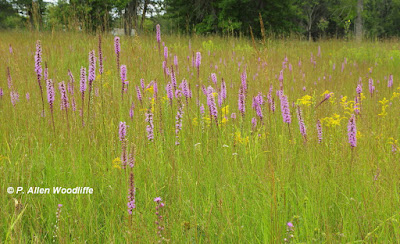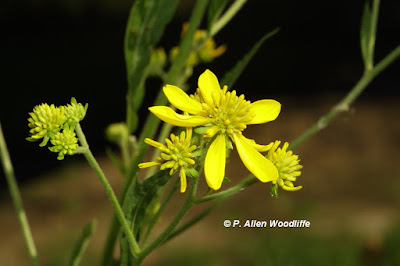This morning, I had several species of warblers in the yard. For anyone who knows where we live, warblers of any kind are a novelty! On migration I might see the occasional one, and only because I planted so many trees when we moved here more than 27 years ago. Today I had a Black-and-white, at least two Bay-breasted, two Wilson's and a Yellow Warbler, all in just a few minutes. I also had a Yellow-bellied Flycatcher, the first one for my yard list.
 |
| Black-and-white Warbler |
One of them has now formed a pupa.......hopefully in less than a couple of weeks, it will emerge successfully.
 | |||||||
| Black Swallowtail pupa |
 |
| Monarch egg |
One time when I was searching for monarch eggs, I came across this tiny Long-legged Fly. And when I looked closer, I saw an even smaller fly being munched on by the Long-legged one! You have to look closely....I didn't realize there were flies that small!
It has been a bad year for Japanese Beetles. Our raspberries and many other plants have been enjoyed by them, it seems. They also like Wild Grape leaves, as evidenced by the 33 or so that were resting, feeding, mating, etc on this grape leaf all at the same time.
According to the experts, the Japanese Beetle traps don't work well. At least not in ridding the beetles from your yard, as the scent actually draws the beetles from throughout the neighbourhood. If you have a trap, it is best to place it away from your yard (like maybe in your neighbour's.......just kidding!). The most effective way of getting rid of the beetles is to collect them in a bucket of soapy water. Unless it is a windy day and they are hanging on tightly, they usually drop down if disturbed. Therefore placing the collecting jar immediately underneath before you jostle them, will usually catch them. We sometimes collected over 100 a day during the peak.
 |
| Bucket of beetles |
It is a nest of an American Goldfinch. The shallow cup of fine hairs is a clue, but the clincher is the ring of baby bird poop ringing the outside of the nest. The adults of many bird species will remove the fecal sac from the nest almost immediately. Not the goldfinch.....they are messy in that regard. I knew they were around, but never knew they were using our yard to nest in.
I found this very small fly visiting our dill. It isn't much bigger than the tiny flower. Thank goodness for a good macro lens!
 |
| Toxomerus marginatus |
A Large Milkweed Bug (not a beetle, which has a different wing type) was on some of the various Echinacea plants.
 |
| Large Milkweed Bug |
 |
| Carolina Sphinx caterpillar |
This one has been parasitized by a Braconid wasp. The adult wasp has laid its eggs inside the caterpillar, and when the larvae hatch, they feed on the insides of the caterpillar. After a few days, they emerge and form their pupae, looking like small eggs, on the outside of the caterpillar. By this time the caterpillar has had much of its insides sucked out but may live a bit longer, at least until the pupae emerge. A tough life for a hornworm caterpillar, but the gardener can appreciate this natural control.
























































